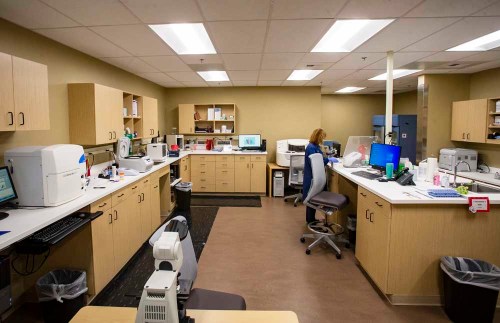Umatilla County to move out of extreme risk category
Published 2:30 pm Wednesday, February 24, 2021

- Michelle Sitz, a medical technologist with Yellowhawk Tribal Health Center, works in the laboratory at the health center on Dec. 18, 2020. In a joint statement with Oregon Health Authority, Yellowhawk announced Wednesday that the state had failed to electronically record more than 1,400 tests reported by Yellowhawk between June 2020 and January 2021.
SALEM — Umatilla County has been moved from the extreme coronavirus risk category to the high risk category after county officials appealed to the state this week regarding a recently reported backlog of tests that for months was mishandled by the Oregon Health Authority.
A joint statement from OHA and Yellowhawk Tribal Health Center at the Confederated Tribes of the Umatilla Indian Reservation on Wednesday, Feb. 24, announced that the state had failed to electronically record more than 1,400 tests reported by Yellowhawk between June 2020 and Jan. 2021.
The error occurred when the state switched from manual data entry to a new electronic system, causing “data processing issues” that resulted in the backlog. The state said it “regrets the error and has since been working closely with the (CTUIR) to prevent these errors from happening again.”
After the backlogged tests were reported, county officials successfully appealed to Gov. Kate Brown’s office on Feb. 22 and on Feb. 23 the state announced that the county would be moved to high risk.
“In the end this is wonderful news for our local businesses and for our schools,” Umatilla County Commissioner George Murdock said in an email. “We won’t be able to get back to full operation, but every step counts.”
The change allows indoor and outdoor recreation, entertainment and shopping and retail establishments to reopen at limited capacity. It also allows faith institutions, funeral homes, mortuaries and cemeteries to reopen at limited capacity. Lastly, it allows indoor and outdoor visitation at long-term care facilities and only recommends, rather than requires, that office work be done remotely.
The county’s move from the extreme risk category to the high risk category becomes effective on Feb. 26. Since the state started the four-tiered risk categories in December, Umatilla County has been firmly entrenched in the extreme risk category. This is the county’s first move out of the classification.
County officials were flooded with calls on Feb. 20 from concerned residents after the state reported the backlogged tests, which showed that the county had a spike of 72 new coronavirus cases.
Halley Maloy, the county’s epidemiologist, sorted through the tests over the weekend with county health officials to determine what cases should be included and what cases should be excluded from the county’s reopening metrics.
Their analysis showed that 1,145 of those tests, accounting for 74 recently reported positive cases, were either from before Feb. 1, when the two-week time frame to determine risk levels began, or from inmates at local prisons. At least one of those cases was from as far back as June, said Joe Fiumara, the county’s public health director.
“The way it got reported from the state, which I didn’t like, very much made it seem like we screwed something up here locally,” Fiumara said. “And that was not in fact what happened.”
The approval from the governor’s office to discount the cases drops reported cases over the past two weeks from 231 to 156, according to the health department, which dropped county case rates to 191 cases per 100,000 from Feb. 7 to Feb. 20 and made the county eligible to be lowered to high risk.
“The accurate collection and accounting of all COVID-19 case data informs OHA’s ongoing response to COVID-19, and we are committed to informing the public when we identify any oversight,” said Dr. Dean Sidelinger, state public health officer and epidemiologist. “When we identified the issue, we worked to correct our methods of capturing case data, and we want to thank the Confederated Tribes of the Umatilla Indian Reservation for the work they are doing to provide their case and investigation data to us.”
A total of 58 of the reported cases were from Yellowhawk Tribal Health Center, which has been reporting cases to the state since the pandemic began despite being an entity of a sovereign nation that is not required to do so.
“We decided to be transparent with our data because we realize this will be an important part to fighting the virus and protect not only residents of the Umatilla Indian Reservation but our community, county and state,” said Lisa Guzman, chief executive officer for the Yellowhawk Tribal Health Center.
Four more cases were from Aegis Sciences Corporation, and nine were from inmates at local prisons. All those cases were excluded and do not reflect recent counts.
Eastern Oregon showed improvement, with Umatilla County’s move and Union and Malheur counties making big jumps, going from extreme to moderate level. Morrow County remains at moderate risk.
County risk levels that go into effect Friday, Feb. 26:
Lower Risk (10)
• Baker
• Clatsop (Moved from High)
• Gilliam
• Grant
• Lincoln (Moved from High)
• Sherman
• Tillamook
• Wallowa
• Wasco (Moved from Extreme)
• Wheeler
Moderate Risk (10)
• Clackamas (Moved from High)
• Curry (Moved from Lower)
• Harney (Moved from Lower)
• Hood River (Moved from High)
• Lake
• Linn (Moved from High)
• Malheur (Moved from Extreme)
• Morrow
• Union (Moved from Extreme)
• Washington (Moved from High)
High Risk (11)
• Columbia
• Crook (Moved from Extreme)
• Deschutes
• Jackson (Moved from Extreme)
• Klamath
• Lane (Moved from Extreme)
• Marion (Moved from Extreme)
• Multnomah
• Polk (Moved from Extreme)
• Umatilla (Moved from Extreme)
• Yamhill (Moved from Extreme)
Extreme Risk (5)
• Benton
• Coos
• Douglas (Moved from High)
• Jefferson
• Josephine









